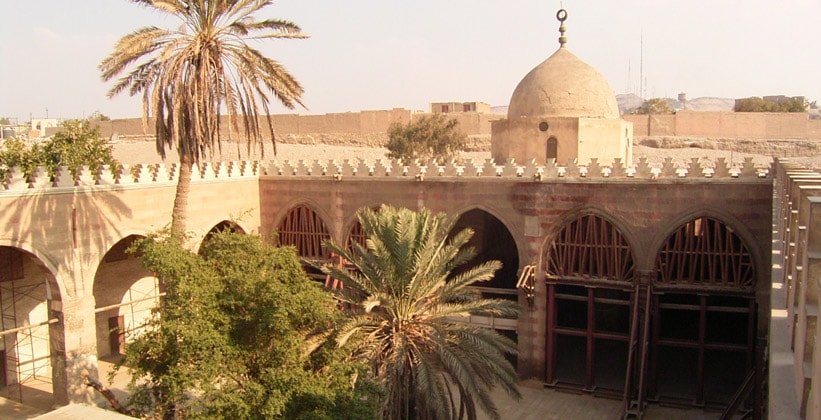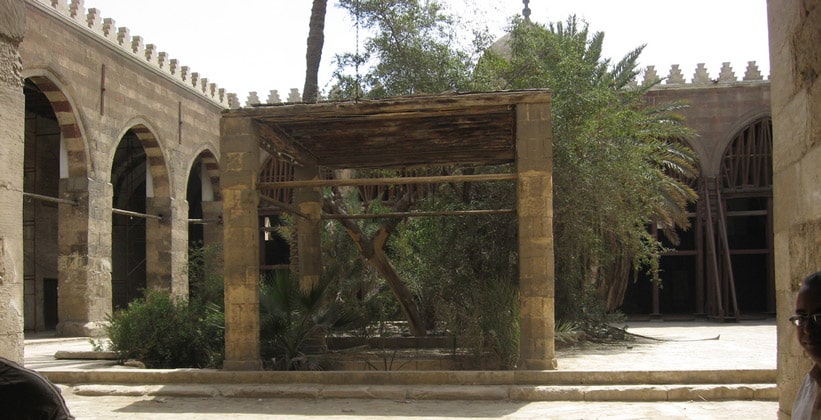Further down the street, which is now called Shariah Bab al-Wazir along the Vizier’s Gate, which once stood here, is the Blue Mosque, or Aksunkur Mosque, which can be reached by minibus No. 68 from Midan Ramses or Bab Zuweil or No. 75 from Midan Tahrir . At the time of writing, it was closed for restoration. In 1347, when the mosque was built, it was more modest, the ablak arches surrounded the central Sahn courtyard with palm trees and chirping birds, which has now become sloppy and dusty.
Tiles in the Iznik style (brought from Turkey or Syria) appeared in the 1650s, under Ibrahim-ag, who appropriated a 14th-century mosque and redecorated it. A tile of indigo and turquoise color on the qibla wall, on both sides of the beautifully decorated mihrab – with cypresses, tulips and other floral motifs – appeared at the same time. The same tile, apparently made in Damascus, can be seen around the tomb of Ibrahimaga in the southwestern corner of the mosque. Thanks to this ceramic decor, the mosque was called “Blue” and gained such popularity among tourists.

The marble minbar, encrusted with orange-pink, plum, green and gray stone, remained from the original building, as well as the recently restored round minaret, which offers a beautiful view of the Cairo Citadel , and on a clear day you can even see the pyramids at the far end of the city. The founder of the mosque, Shame ad-Din Aksunkur, was plotting against the heirs of Sultan Al-Nasir, his father-in-law, whose son Al-Ashraf Kuchuk (“Baby”) ascended the throne at the age of six, “reigned” for five months and was strangled by his brother for three years later.
The reign of al-Kamil Shaban (not to be confused with Shaban II, who built the madrassah) lasted a year, ended with a palace coup and the accession to the throne of his son-in-law Muzafar Haji. Remembering how Aksunkur manipulated Kuchuk (who was buried near the entrance to the mosque) and deftly organized a conspiracy against Shaban, Muzaffar soon ordered him to be strangled. From this mosque, Bab al-Wazir street goes down and connects with the road leading to the Citadel. If you go there, turn left and go up.

A couple of hundred meters west of the Blue Mosque, there was the Bashtak hammam, a bathhouse that served the residents of the Darb al-Ahmar quarter. Many dwellings in the area lacked amenities. But now these baths are closed, like most of the traditional steam baths of Islamic Cairo . The artfully decorated portal of the building deserves a close look. A small towel is depicted on the lancet arch – a symbol of the jamdar, or “wardrobe caretaker”.
In Mamluk society, the position of Jamdar was lower than that of the “people of the sword” (ministers elected from hundreds of emirs), but at the same level as the court ranks of a taster, cup-bearer, keeper of shoes and keeper of a polo club. Several Mamelukes, who later became sultans, included the name of their former position (or the price paid for them when they were slaves) in their titles.
To get to the Citadel from Hamam, walk 300 meters along Sharia Suk es-Silah (it used to be an arms market, now it is a place where they sell used ball bearings) past Sabil Kuttaba Rukayi Dudu (No. 41) with a pompous dilapidated facade and al-madrasah Yusufi, the founder of which was the Sasan’s shell-bearer.
WhatsApp us